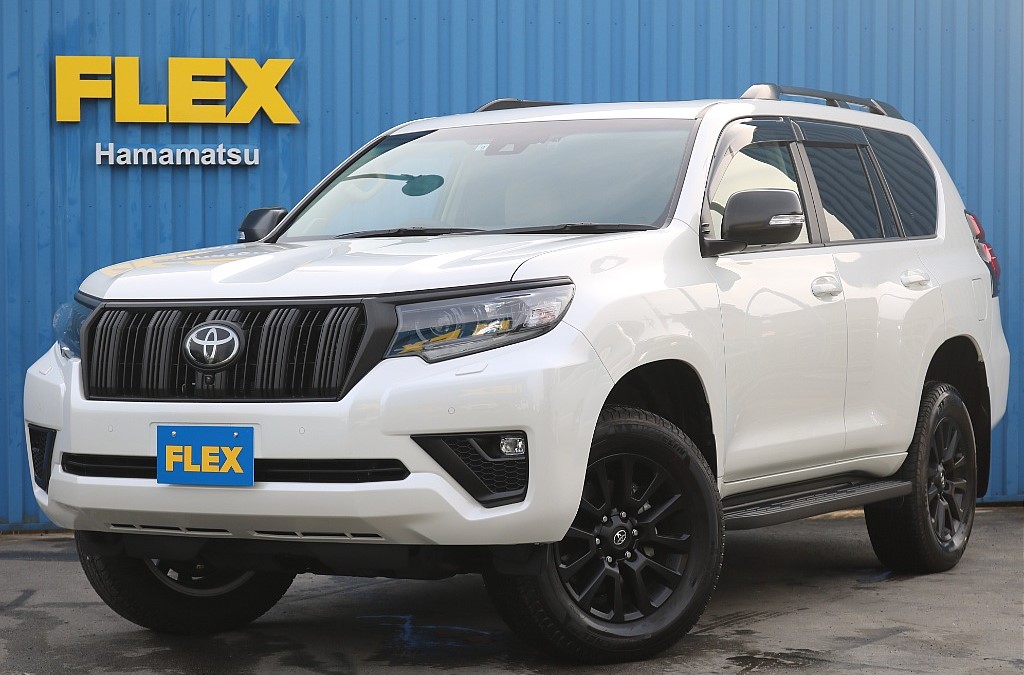The Land Cruiser Prado (known as the Land Cruiser in North America) is trusted and in use worldwide
Since the introduction of the first Prado (70 series) in 1990 to the present, the Land Cruiser Prado has evolved through generational changes to the 90 series, 120 series, and 150 series. Each model has its own characteristics, and its popularity cannot be expressed in a single word.
However, as a member of the Land Cruiser family that has been recognized and sold worldwide, the greatest attraction shared by all is its high level of reliability and overall driving performance. As a wagon derived from the Land Cruiser 70 series van, which is the successor to the heavy-duty Land Cruiser 40 series, it has evolved with a shift towards a more comfortable passenger car.
Luxury or not, at the root of this vehicle there is still a Land Cruiser. There are some hard core Land Cruiser enthusiasts who say that the Prado after the Land Cruiser 90 series, which shares the chassis with the Hilux Surf, is not a real Land Cruiser. The Prado became independent of the Land Cruiser 70 series and is recognized worldwide. In Japan, in addition to its performance as a 4WD, its size and utility, which are suitable for road conditions and garage sizes, are highly valued, and there is a steady supply of used vehicles.
Let’s take a look at the features and appeal of successive Land Cruiser Prado models.
No North American Version of the Prado
When Toyota determined which vehicles to introduce to the North American marketplace, the Prado did not make the cut due to a lack of market demand, as well as cost factors to bring the Prado in line with the regulatory requirements of that time. The Prado was already well-established internationally, and it didn’t make economic sense to change the vehicle at that time.
Instead, Toyota continued the Prado lineup around the world and equipped the Lexus GX and the 4-Runner with the Prado features to create a light-duty SUV for the North American market.
Predecessor of Prado: Land Cruiser 70 Wagon (1985-1990)
When the 4Runner hit the North American market in 1984, it didn’t take long to pique the interest of adventure-seeking souls in the U.S. With its styling and 4WD pedigree derived from Toyota’s well-known truck, the 4Runner was an instant hit with Americans.
The first generation had two doors and a removable top and was only available in two models powered by a carbureted 2.4L 22R inline-4 with a 5-speed manual transmission and a 2-speed transfer case. All models had manual locking front hubs, solid front axles, and leaf springs in the rear, which had a tailgate rather than a swing door.

Land Cruiser 70 Prado (1990-1996), the first model bearing the name of “Prado”
The Land Cruiser 70 series wagon underwent a major change, was given a dedicated front design, was named “Prado” (Japan only) and is a memorable model that charted its own course.
Toyota added an 8-seat/4-door model, as well as an automatic transmission, which made it familiar to all drivers, and that attracted a lot of buyers. In addition, through the addition of a wide-fender model (3-number car) and changes such as installing a more powerful engine, the unpopular 70 series wagon changed completely, which transformed the Prado into a very popular vehicle. It had a 2.4-liter in-line 4 diesel turbo engine with electronic control, and the transmission was available as an electronically controlled 4-speed full automatic or as a conventional 5-speed manual.

Ultimately, a more powerful 3-liter straight-4 diesel turbo was installed, which removed the idea that the Prado was weak. In the interior, the dashboard of the late model was more rounded and improvements were made to dispel the truck smell of the previous model, actively promoting differentiation from the van. With these improvements and changes, it is a model that has increased its unique user base, which is different from the conventional 70 series fans.
Land Cruiser 78 Prado (1990-1996)
Tucked into the Land Cruiser lineage is the Prado 78, which appeared in 1990 and disappeared in 1996. It was available in four models and was diesel-powered in most countries except for a few overseas markets where it was gas-powered.

The 78 Prado was derived from the 70 Series trucks, and it was given a troop carrier designation since it had a wider stance and could carry 8 passengers in its 4-door body. It still had the same 4WD capabilities as all the rest of the Land Cruisers on the market, and because of its size, was quite popular with commercial industries. Not sold in the U.S.
Land Cruiser 90 Prado with many specifications (1996-2002)
The Land Cruiser 90 Prado is a model in which the Prado, which was one of the 70 series until then, became independent and was given a new model. Many fans remember that it was developed with a strong resemblance to the Mitsubishi Pajero, which was selling well at the time, and the resemblances became a topic of discussion regarding the Prado.

The Prado’s first gasoline engine was added to the domestic specifications, and the late model introduced a new-generation common rail diesel. In addition to this, many groundbreaking improvements were made for cross-country 4WD at the time, such as the independent front suspension. As for the body variations, the 3-door short (90 Prado) and the 5-door long (95 Prado) have a standard (narrow) body and a wide body, respectively, and there were many models, so there were many choices for the 90 series Prado. It was both a feature and an attraction.
In addition to this, there were optional package specifications, camper specifications, and a 5-door long car “5-seater specification”, so there were more than 60 options at the time. The interior was also redesigned, and the instrument panel, which deviated from a work truck appearance, influenced many cross-country 4WDs that followed. The 70 Prado can be said to be an important model that has expanded the base of Land Cruiser users.
The upgraded Land Cruiser 120 Prado (2002-2009)
The Prado 120 began the third generation in 2002 and it ran until 2007. The new Prado featured a rigid frame that improved its maneuverability, as well as made the cabin much quieter. On and off-road performance was upgraded by the new Torsen® LCD transfer unit in the center differential.
Toyota installed an active traction control system capable of making minute adjustments in traction during uphill and downhill driving, keeping you connected with the terrain. The rear air suspension enhanced on-road ride comfort.

The 120 was available equipped with a 3.4L or a 3.7L V6 gas-powered engine, or a 3.0L intercooled turbo diesel motor.
For the North American market, Lexus GX was released as a high-end version of the 120.
The Lexus GX first generation began in 2002 as the GX 470 and as a 2003 model. This reinvention of the Prado 120 shared a platform with Toyota’s 4Runner, which was the Prado 120 wearing the North American Toyota badge on its grille.
The GX 470 was the luxury version, and the 4Runner was geared more toward adventure seekers and off-road enthusiasts.
To power the GX 470, Lexus put a 4.7L 2UZ-FE v8 under the hood, and the 4Runner was offered with that engine as an upgrade or a base equipped 4.0L 1GR-FE V6. Both engines were gas-powered.
The GX had a 5-speed automatic transmission that it shared with the upper 4Runner models, while the lower-end 4Runner was equipped with a 4-speed automatic.
Both vehicles had a wheelbase of 109.8 inches and approximately the same height, width, and length dimensions. However, the curb weight of the GX was 4,871 pounds versus the 4Runner’s 4,280 pounds.
There’s a world of difference between the two when it comes to pricing. The base Lexus GX 470 started at $61,855 and the base Toyota 4Runner had a starting MSRP of $26,335 with a top range of $36,105, which is still considerably lower than the Lexus GX.
Lexus GX was released as a high-end version of the Prado 120 (2022-), and the 4Runner was the Toyota version of the 120 Series with a more reasonable price tag.
Advanced technology, Land Cruiser 150 Prado (2009- )
The Land Cruiser 150 Prado has matured enough that it is now distinct from the 120 Prado because of its premium features. The 3-door short car for the domestic market was discontinued and only the 5-door long wide body was available, but the most notable point is the return of the diesel model for the first time in about eight years.

The latest technology advanced the vehicle even further as it adopted a 5-speed automatic transmission equipped with a sequential shiftmatic, setting an improved Kinetic Dynamic Suspension System (KDSS), and “multi-terrain select” where you can choose a driving mode according to the road conditions. It is equipped with many advanced features like the “multi-terrain monitor” that allows you to check the surrounding road conditions via an in-vehicle camera.
The current lineup includes a 2.7-liter straight-4 gasoline engine (6-speed automatic), which has been further powered up since the 120 series era, and a newly developed 2.8-liter straight-4 DOHC diesel turbo. At the same time as the diesel revival, the 4-liter V6 gasoline 1GR-FE type was discontinued only for the domestic market. Seven years after its debut, the current model 150 Prado has reached maturity. There are building expectations that there will be a new model soon.
The 250 Series in Japan replaces the Prado Series (2024)
Things have changed since the first Prado, and today, Toyota has brought the Prado back to Japan and finally introduced it to the North American audience.

Photo by Toyota
In doing so, the Prado name gets lost in the translations as the new models are introduced, even though they are all based on the Prado light-duty body style.
Japan will see it as the 250 Series, and the Toyota dealerships in North America will have Land Cruisers on their showroom floors. The 250 will be a move back to the basics by providing a basic family-oriented 4WD vehicle less focused on utilitarianism and more on taking the kids to school.
This new Japanese model will come in two trim levels and one limited First Edition model for both trim levels. The VX is available with both diesel and gas power options.
For the North American markets, there will be two models and one limited first edition model. All of the North American versions are hybrid-powered but don’t look for the 250 Series name. All North American models wear the Land Cruiser name because Toyota is taking advantage of the popularity and familiarity of the nameplate.




